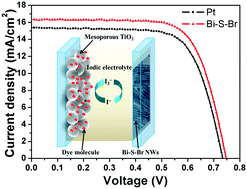Bismuth-based ternary nanowires as efficient electrocatalysts for dye sensitized solar cells†
Abstract
Bismuth-based ternary nanowires (NWs), including Bi19S27Br3 and Bi19S27I3, have been exploited as cost-effective and highly efficient Pt-free electrocatalysts in dye sensitized solar cells (DSSCs). Devices with them as counter electrodes (CEs) display a power conversion efficiency (PCE) of over 8.70%, superior to that of a cell with Pt as a CE (7.99% PCE) under the same conditions.


 Please wait while we load your content...
Please wait while we load your content...